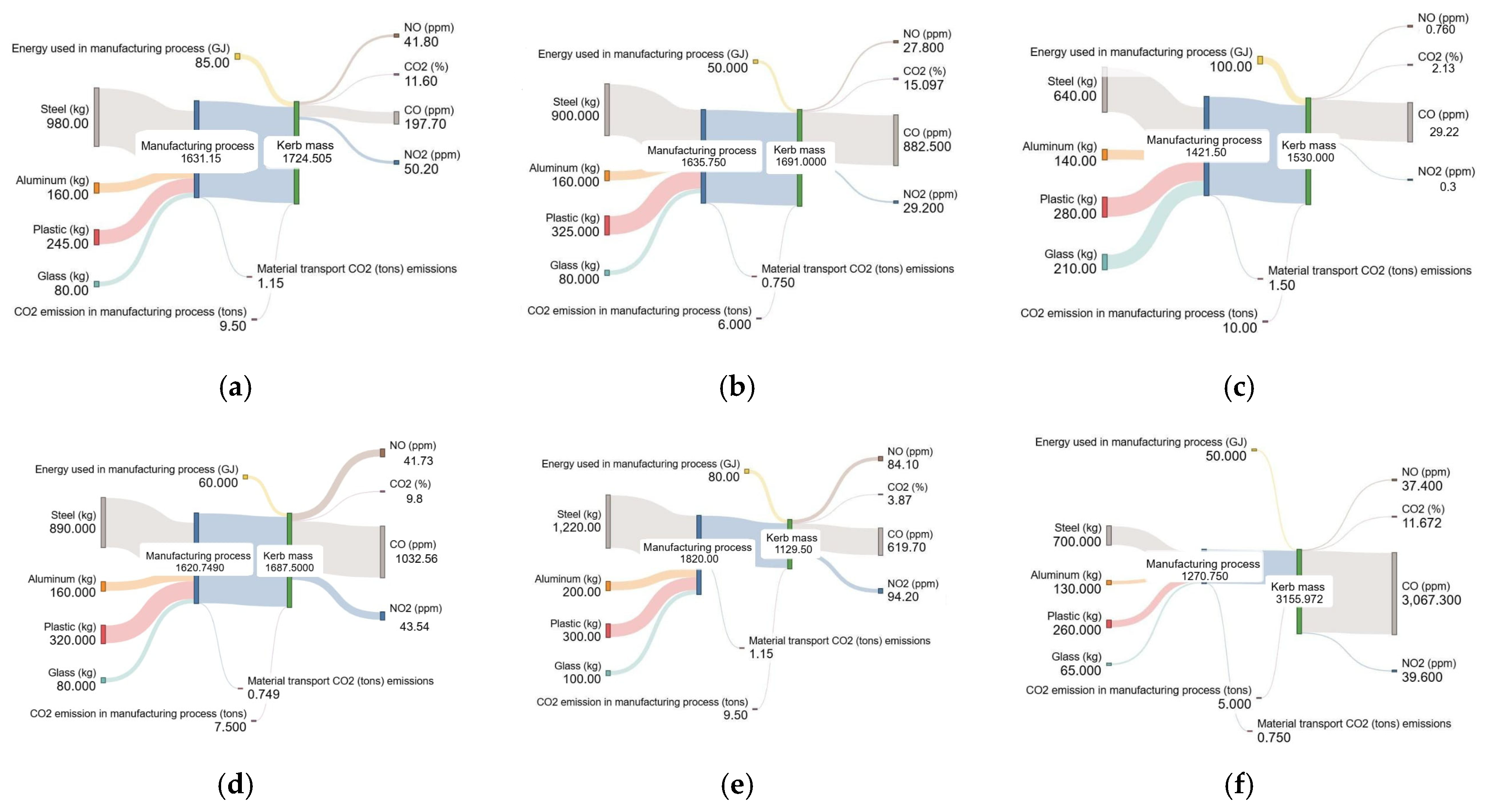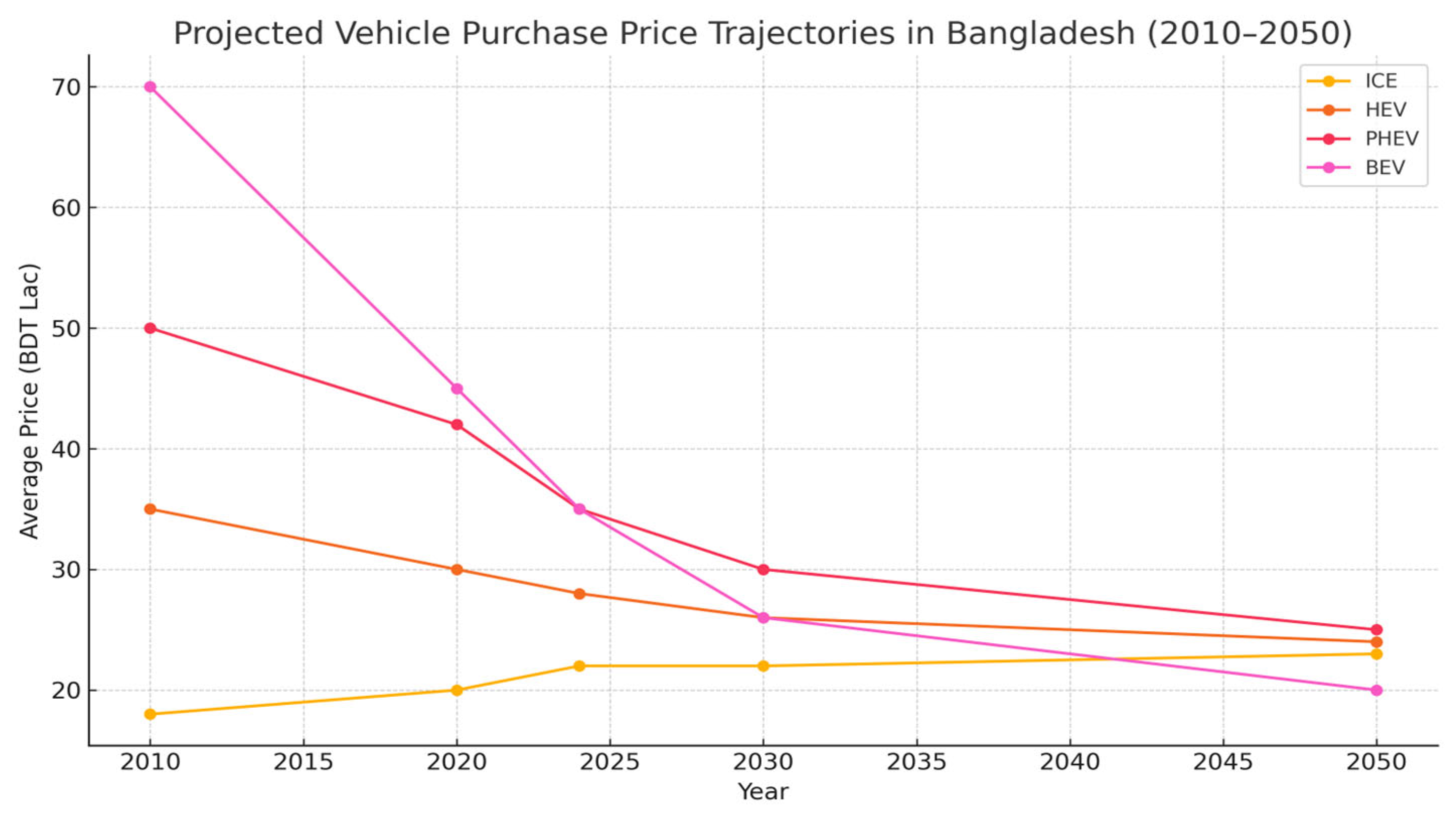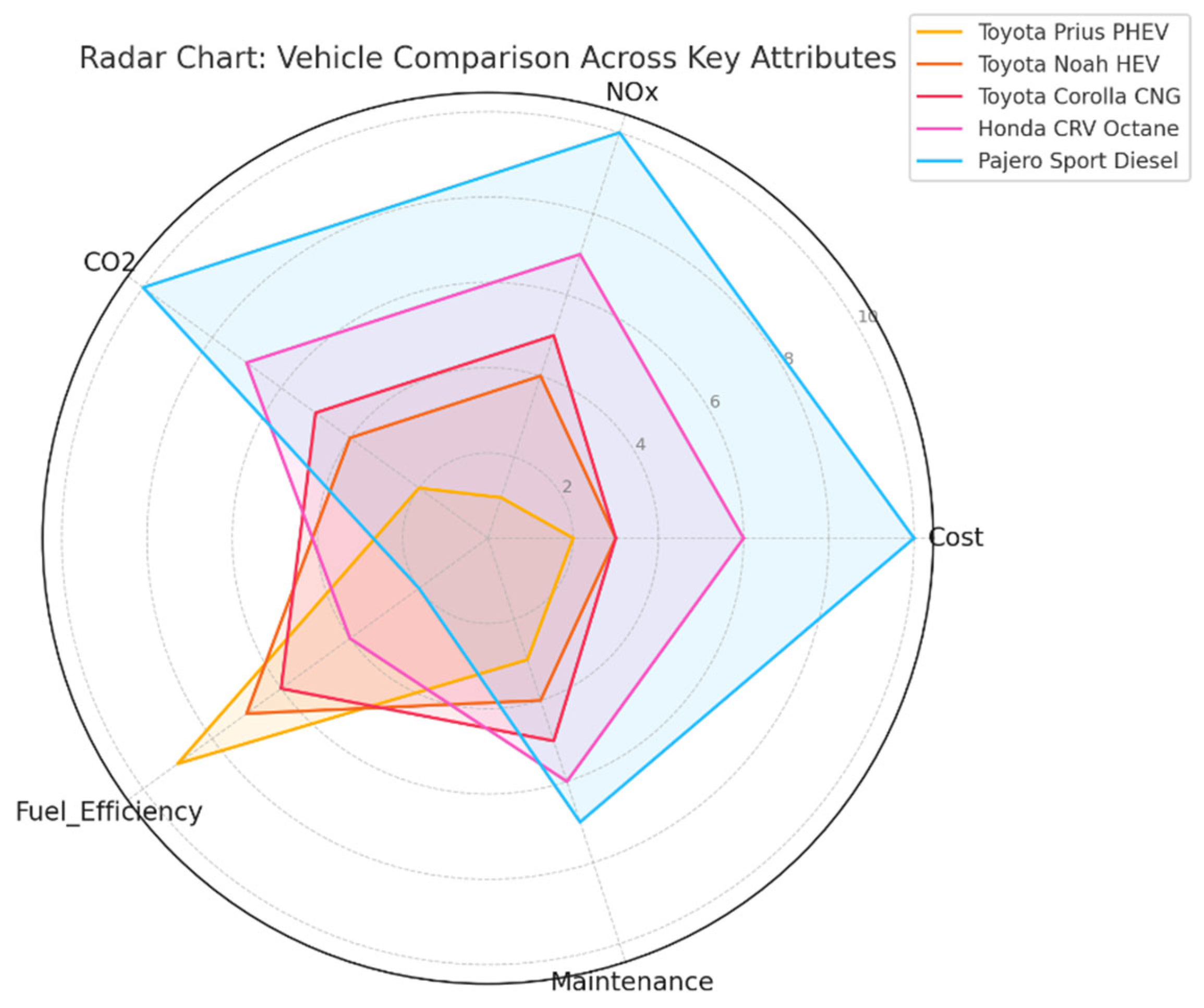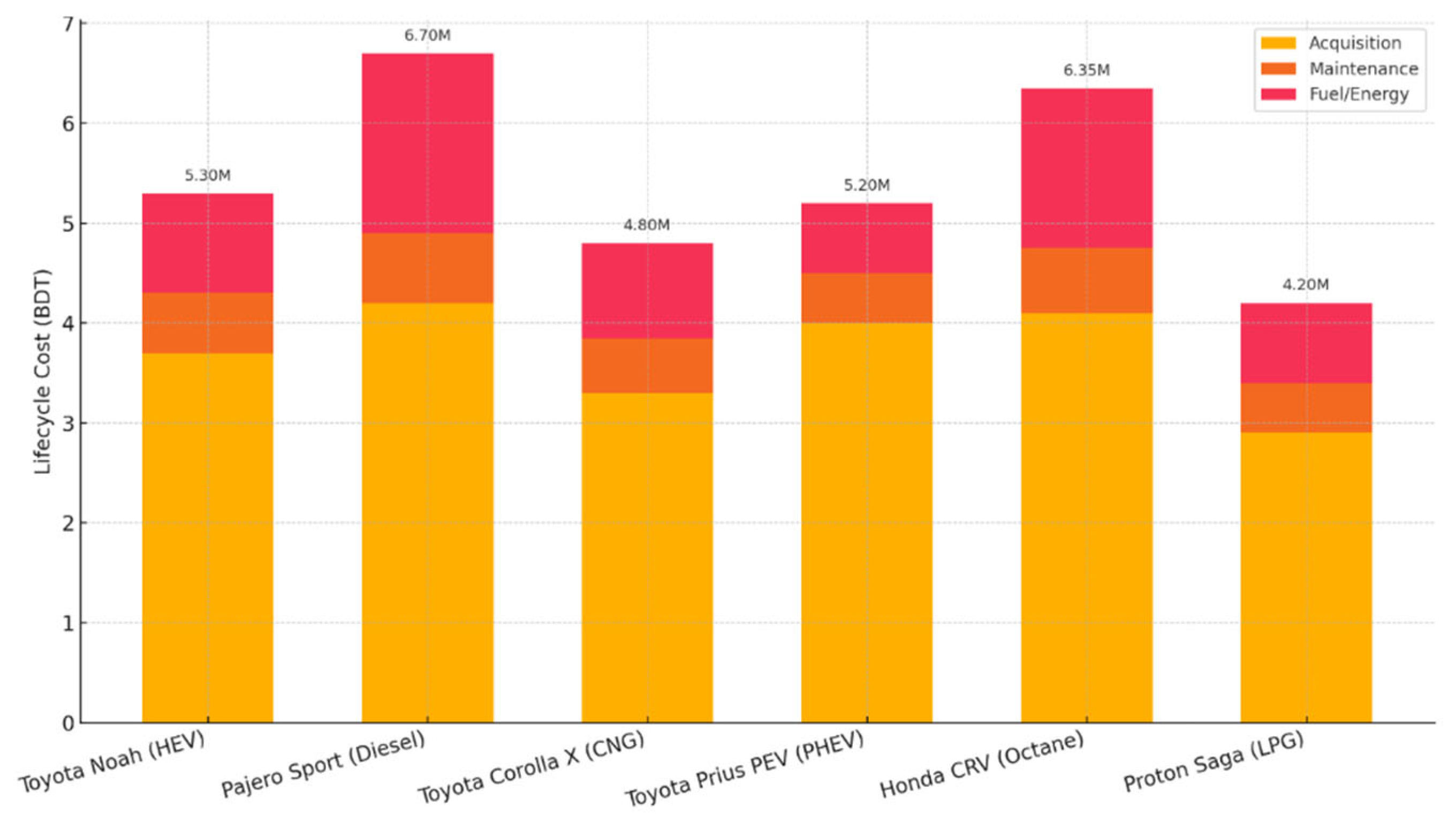Transitioning to Cleaner Transport: Evaluating the Environmental and Economic Performance of ICE, HEVs, and PHEVs in Bangladesh
Abstract
1. Introduction
2. Methodology
2.1. Data Collection
2.1.1. Vehicle Selection and Sampling
2.1.2. Emission Testing Protocol
2.1.3. Well-to-Wheel (WTW) Emissions
2.1.4. Fuel Price Trend
2.1.5. Data Source and Quality Validation
2.2. Data Analysis
2.2.1. Emission Data Analysis
2.2.2. Lifecycle Assessment (LCA)
- I.
- Manufacturing phase: Raw material extraction, vehicle production, and assembly.
- II.
- Operational phase: Fuel/energy consumption and emissions during use.
- III.
- End-of-life phase: Recycling, waste disposal, and salvage value.
- I.
- Electricity grid composition: 62% natural gas, 30% fossil fuels, 2% coal, 2% renewables [27].
- II.
- Vehicle manufacturing data: ICE vehicles dominate, reducing EV production offsets.
- III.
- Battery recycling rates: Estimated at 15%, based on Dhaka’s informal sector practices.
2.2.3. Economic Analysis
- Fuel Costs:
- I.
- CNG: 50 BDT/L
- II.
- LPG: 70 BDT/L
- III.
- Octane: 130 BDT/L
- IV.
- Diesel: 110 BDT/L
- V.
- Electricity: 8 BDT/kWh [29]
- Manufacturer data and surveys from 20 automobile workshops in Dhaka were analyzed. From the performed survey and a comparison with similar foreign scenarios of vehicle markets, the following observations were made:
- Lifecycle Costs:
- I.
- Purchase prices were collected from local dealerships.
- II.
- Depreciation: ICE vehicles dropped to 1/4th of their buying price, and 1/5th for EVs. Due to the degradation of the battery, BEVs greatly depreciate in value [32].
- III.
- Salvage value: 5% (ICE), 10% (EV).
- IV.
- Discount rate: 7% [33].
- V.
- Life expectancy: 20 years as per BRTA’s advisory order for private vehicles [34].
2.3. Model Accuracy and Uncertainty
3. Results
3.1. Material Composition and Production Impact
3.2. Emission Profile
3.3. Lifecycle Energy and Emissions
3.4. Economic and Fuel Efficiency Analysis
4. Discussion
5. Conclusions
Author Contributions
Funding
Institutional Review Board Statement
Informed Consent Statement
Data Availability Statement
Conflicts of Interest
References
- World Bank. Country Climate and Development Report; South Asia; World Bank Group: Dhaka, Bangladesh, 2022; p. 62. [Google Scholar]
- Worldometer Bangladesh CO2 Emissions. Available online: http://www.worldometers.info/co2-emissions/bangladesh-co2-emissions/ (accessed on 11 May 2025).
- Elgowainy, A.; Han, J.; Ward, J.; Joseck, F.; Gohlke, D.; Lindauer, A.; Ramsden, T.; Biddy, M.; Alexander, M.; Barnhart, S.; et al. Current and Future United States Light-Duty Vehicle Pathways: Cradle-to-Grave Lifecycle Greenhouse Gas Emissions and Economic Assessment. Environ. Sci. Technol. 2018, 52, 2392–2399. [Google Scholar] [CrossRef] [PubMed]
- Gan, Y.; Lu, Z.; He, X.; Wang, M.; Amer, A.A. Cradle-to-Grave Lifecycle Analysis of Greenhouse Gas Emissions of Light-Duty Passenger Vehicles in China: Towards a Carbon-Neutral Future. Sustainability 2023, 15, 2627. [Google Scholar] [CrossRef]
- Huang, X.; Zhang, Y.; Li, D.; Han, L. An optimal scheduling algorithm for hybrid EV charging scenario using consortium blockchains. Future Gener. Comput. Syst. 2019, 91, 555–562. [Google Scholar] [CrossRef]
- Ahmadi, L.; Croiset, E.; Elkamel, A.; Douglas, P.L.; Unbangluang, W.; Entchev, E. Impact of PHEVs Penetration on Ontario’s Electricity Grid and Environmental Considerations. Energies 2012, 5, 5019–5037. [Google Scholar] [CrossRef]
- Yuksel, T.; Michalek, J.J. Effects of Regional Temperature on Electric Vehicle Efficiency, Range, and Emissions in the United States. Environ. Sci. Technol. 2015, 49, 3974–3980. [Google Scholar] [CrossRef]
- Shen, H.; Zhou, X.; Ahn, H.; Lamantia, M.; Chen, P.; Wang, J. Personalized Velocity and Energy Prediction for Electric Vehicles with Road Features in Consideration. IEEE Trans. Transp. Electrif. 2023, 9, 3958–3969. [Google Scholar] [CrossRef]
- Srinivasa Raghavan, S.; Tal, G. Influence of User Preferences on the Revealed Utility Factor of Plug-In Hybrid Electric Vehicles. World Electr. Veh. J. 2020, 11, 6. [Google Scholar] [CrossRef]
- Offer, G.J.; Contestabile, M.; Howey, D.A.; Clague, R.; Brandon, N.P. Techno-economic and behavioural analysis of battery electric, hydrogen fuel cell and hybrid vehicles in a future sustainable road transport system in the UK. Energy Policy 2011, 39, 1939–1950. [Google Scholar] [CrossRef]
- Santini, D.; Burnham, A. Reducing Light Duty Vehicle Fuel Consumption and Greenhouse Gas Emissions: The Combined Potential of Hybrid Technology and Behavioral Adaptation. SAE Int. J. Altern. Powertrains 2013, 2, 314–324. [Google Scholar] [CrossRef]
- Park, C.; Shin, J. Forecasting of changes in electricity consumption due to EV diffusion in South Korea: Development of integrated model considering diffusion and macro-econometric model. Technol. Forecast. Soc. Chang. 2024, 209, 123747. [Google Scholar] [CrossRef]
- Mily, S.N.; Bashirul, M.; Islam, M.A. Unveiling the consequence of unprecedented fuel price hike in Bangladesh on consumer travel behavior. Sustain. Transp. Livability 2024, 1, 2409081. [Google Scholar] [CrossRef]
- Long, Z.; Axsen, J.; Kormos, C.; Goldberg, S. Latent demand for zero-emissions vehicles in Canada (Part 1): Insights from a design space exercise. Transp. Res. Part D Transp. Environ. 2019, 67, 51–66. [Google Scholar] [CrossRef]
- Karmaker, A.K.; Hossain, M.A.; Manoj Kumar, N.; Jagadeesan, V.; Jayakumar, A.; Ray, B. Analysis of Using Biogas Resources for Electric Vehicle Charging in Bangladesh: A Techno-Economic-Environmental Perspective. Sustainability 2020, 12, 2579. [Google Scholar] [CrossRef]
- Suman, N.H.; Chyon, F.A.; Ahmmed, S. Business strategy in Bangladesh—Electric vehicle SWOT-AHP analysis: Case study. Int. J. Eng. Bus. Manag. 2020, 12, 1847979020941487. [Google Scholar] [CrossRef]
- Veza, I.; Asy’ari, M.Z.; Idris, M.; Epin, V.; Rizwanul Fattah, I.M.; Spraggon, M. Electric vehicle (EV) and driving towards sustainability: Comparison between EV, HEV, PHEV, and ICE vehicles to achieve net zero emissions by 2050 from EV. Alex. Eng. J. 2023, 82, 459–467. [Google Scholar] [CrossRef]
- González Palencia, J.C.; Otsuka, Y.; Araki, M.; Shiga, S. Scenario analysis of lightweight and electric-drive vehicle market penetration in the long-term and impact on the light-duty vehicle fleet. Appl. Energy 2017, 204, 1444–1462. [Google Scholar] [CrossRef]
- Rahman, M.M.; Deb, S.; Strawderman, L.; Burch, R.; Smith, B. How the older population perceives self-driving vehicles. Transp. Res. Part F Traffic Psychol. Behav. 2019, 65, 242–257. [Google Scholar] [CrossRef]
- BPDB. BPDB|Power Generation Unit. Available online: https://misc.bpdb.gov.bd/power-generation-unit (accessed on 11 May 2025).
- Khan, M.D.H.; Sarkar, M.S.; Haque, S.S.; Hossain, M.A. Health Risk Assessment of Black Carbon Emission from Fossil Fuel. J. Eng. Sci. 2021, 12, 23–28. [Google Scholar] [CrossRef]
- Prussi, M.; Yugo, M.; De, P.L.; Padella, M.; Edwards, R.; Lonza, L. JEC Well-to-Tank Report v5. Available online: https://publications.jrc.ec.europa.eu/repository/handle/JRC119036 (accessed on 11 May 2025).
- CPD. Record Fuel Price Hike in Bangladesh—Could It Be Avoided; CPD: Dhaka, Bangladesh, 2022. [Google Scholar]
- HCU; MoE. Energy Scenario of Bangladesh 2022–23; HCU: Dhaka, Bangladesh, 2024. [Google Scholar]
- Jones, R. Decarbonizing Long-Haul Trucking. Doctoral Thesis, Massachusetts Institute of Technology, Cambridge, MA, USA, 2024. [Google Scholar]
- Li, C.; Swanson, J.; Pham, L.; Hu, S.; Hu, S.; Mikailian, G.; Jung, H.S. Real-world particle and NOx emissions from hybrid electric vehicles under cold weather conditions. Environ. Pollut. 2021, 286, 117320. [Google Scholar] [CrossRef]
- Mahbub, T. Energy in Bangladesh: From scarcity to universal access. Energy Strategy Rev. 2024, 54, 101490. [Google Scholar] [CrossRef]
- Lim, O.; Yoon, S. Comparative Life Cycle Assessment of Liquefied Natural Gas and Marine Fuel for Ship from Well to Hull. J. Hydrog. New Energy 2021, 32, 127–133. [Google Scholar] [CrossRef]
- BPDB. Bangladesh Power Development Board Tarrif Rate. Available online: https://bpdb.gov.bd/site/page/c413c44f-9611-4320-82da-b298fe69157e/%E0%A6%9F%E0%A7%8D%E0%A6%AF%E0%A6%BE%E0%A6%B0%E0%A6%BF%E0%A6%AB-%E0%A6%B0%E0%A7%87%E0%A6%9F (accessed on 11 May 2025).
- Needell, Z.A.; McNerney, J.; Chang, M.T.; Trancik, J.E. Potential for widespread electrification of personal vehicle travel in the United States. Nat. Energy 2016, 1, 16112. [Google Scholar] [CrossRef]
- Litman, T. New Mobilities: Smart Planning for Emerging Transportation Technologies; Island Press: Washington, DC, USA, 2021; ISBN 978-1-64283-145-0. [Google Scholar]
- Khaled, M.S.; Abdalla, A.M.; Abas, P.E.; Taweekun, J.; Reza, M.S.; Azad, A.K. Life Cycle Cost Assessment of Electric, Hybrid, and Conventional Vehicles in Bangladesh: A Comparative Analysis. World Electr. Veh. J. 2024, 15, 183. [Google Scholar] [CrossRef]
- Bangladesh Bank. Bangladesh Bank. Available online: https://www.bb.org.bd/en/index.php (accessed on 11 May 2025).
- The Government of People’s Republic of Bangladesh. The Road Transport Act 2018; The Government of People’s Republic of Bangladesh: Dhaka, Bangladesh, 2018.
- Islam, M.A.; Gajpal, Y. Optimization of Conventional and Green Vehicles Composition under Carbon Emission Cap. Sustainability 2021, 13, 6940. [Google Scholar] [CrossRef]
- Winyuchakrit, P.; Sukamongkol, Y.; Limmeechokchai, B. Do Electric Vehicles Really Reduce GHG Emissions in Thailand? Energy Procedia 2017, 138, 348–353. [Google Scholar] [CrossRef]
- Mustika, S.; Wahyu Purwanto, W. Multi-Objective Optimization of Blending Strategy of FAME, HVO, and Petroleum Diesel. IOP Conf. Ser. Mater. Sci. Eng. 2021, 1143, 012046. [Google Scholar] [CrossRef]
- Nunes, L.J.R. Potential of Coal–Water Slurries as an Alternative Fuel Source during the Transition Period for the Decarbonization of Energy Production: A Review. Appl. Sci. 2020, 10, 2470. [Google Scholar] [CrossRef]
- Kurniawan, A.Y.W.; Setiawan, A.A.; Budiman, A. The Impact of Electric Vehicle on Road Transportation in Indonesia: Energy Demand and CO2 Emission. JPSE J. Phys. Sci. Eng. 2020, 5, 36–45. [Google Scholar] [CrossRef]
- New Energy Outlook. BloombergNEF. 2025. Available online: https://about.bnef.com/insights/clean-energy/new-energy-outlook/ (accessed on 15 June 2025).
- World Energy Outlook 2023—Analysis. Available online: https://www.iea.org/reports/world-energy-outlook-2023 (accessed on 15 June 2025).
- Wadud, Z.; Khan, T. Air Quality and Climate Impacts Due to CNG Conversion of Motor Vehicles in Dhaka, Bangladesh. Environ. Sci. Technol. 2013, 47, 13907–13916. [Google Scholar] [CrossRef]
- Chakma, J. High Registration Cost, Taxes Slow Bangladesh’s Shift to Cleaner EVs. Available online: https://www.thedailystar.net/business/news/high-registration-cost-taxes-slow-bangladeshs-shift-cleaner-evs-3773236 (accessed on 15 June 2025).
- Hasan, M.M.; Islam, A.; Islam, M.N.; Ashikujjaman, M.; Hossain, M.A.; Hasan, M.M.; Islam, A.; Islam, M.N.; Ashikujjaman, M.; Hossain, M.A. Identifying key barriers to electric vehicle adoption in Bangladesh: Insights from a survey. J. Mechatron. Electr. Power Veh. Technol. 2024, 15, 138–149. [Google Scholar] [CrossRef]
- Mojumder, M.R.H.; Ahmed Antara, F.; Hasanuzzaman, M.; Alamri, B.; Alsharef, M. Electric Vehicle-to-Grid (V2G) Technologies: Impact on the Power Grid and Battery. Sustainability 2022, 14, 13856. [Google Scholar] [CrossRef]
- Malaysian Automotive Association. Malaysian Automotive Association. Available online: https://www.maa.org.my/statistics.html (accessed on 11 May 2025).
- Li, Y.; Kimura, S. Economic competitiveness and environmental implications of hydrogen energy and fuel cell electric vehicles in ASEAN countries: The current and future scenarios. Energy Policy 2021, 148, 111980. [Google Scholar] [CrossRef]
- Bhuiyan, M.R.A.; Mamur, H.; Begum, J. A brief review on renewable and sustainable energy resources in Bangladesh. Clean. Eng. Technol. 2021, 4, 100208. [Google Scholar] [CrossRef]
- Abas, A.E.P.; Yong, J.; Mahlia, T.M.I.; Hannan, M.A. Techno-Economic Analysis and Environmental Impact of Electric Vehicle. IEEE Access 2019, 7, 98565–98578. [Google Scholar] [CrossRef]
- Shukla, R.M.; Sengupta, S. COP: An integrated Communication, Optimization, and Prediction unit for smart Plug-in Electric Vehicle Charging. Internet Things 2020, 9, 100148. [Google Scholar] [CrossRef]
- The Government of Japan. Kizuna. 2021. Available online: https://www.japan.go.jp/kizuna/_userdata/pdf/2021/winter2021_special_issue/booklet_winter2021_special_issue.pdf (accessed on 11 May 2025).
- Magnus, W.; Rikheim, H.; Hernes, B.; Østenby, A.M. Norway Report 2022; IEA Wind: Oslo, Norway, 2022; p. 7. [Google Scholar]
- Anh, N.N.; Dac, P.T.; Hung, C.D.; Khoa, N.X. The Status of Electric Vehicle in Vietnam and Experiences from Thailand and Indonesia. In Proceedings of the 2022 6th International Conference on Green Technology and Sustainable Development (GTSD), Nha Trang, Vietnam, 29–30 July 2022; pp. 57–61. [Google Scholar]
- Neupane, S.; Shakya, B. Factors Influencing Adoption of Two-Wheeler Electric Vehicles in Nepal. J. Product. Discourse 2024, 2, 63–82. [Google Scholar] [CrossRef]
- UNPD. Country Programme Document for Sri Lanka (2023–2027); UNPD: New York, NY, USA, 2022. [Google Scholar]
- SAARC. SAARC Energy Outlook; SAARC: Kathmandu, Nepal, 2018.
- Shaikh, M.S.; Raj, S.; Babu, R.; Kumar, S.; Sagrolikar, K. A hybrid moth–flame algorithm with particle swarm optimization with application in power transmission and distribution. Decis. Anal. J. 2023, 6, 100182. [Google Scholar] [CrossRef]
- Qader, A.A.; Jingwei, Z.; Shaikh, M.S.; Liu, L. Optical Energy Policy for Electricity Tariff: An Optimization Approach Over Price Integration. IEEE Can. J. Electr. Comput. Eng. 2022, 45, 159–170. [Google Scholar] [CrossRef]






| Vehicle Type | Model Selected | Fuel Type |
|---|---|---|
| ICE (CNG) | Toyota Corolla X 2008 | CNG |
| ICE (Diesel) | Pajero Sport 2015 | Diesel |
| ICE (Octane) | Honda CRV 2017 | Octane |
| ICE (LPG) | Proton Saga 2020 | LPG |
| HEV | Toyota Noah 2018 | Hybrid |
| PHEV | Toyota Prius PEV 2014 | Plug-in Hybrid |
| Year | Petrol | Octane | Diesel |
|---|---|---|---|
| 2010 | 70 | 75 | 55 |
| 2015 | 86 | 89 | 65 |
| 2020 | 86 | 89 | 65 |
| 2022 | 130 | 135 | 114 |
| 2024 | 126 | 130 | 109 |
| Fuel Type | NO Emissions (ppm) | NO2 Emissions (ppm) | CO Emissions (ppm) | CO2 (%vol) |
|---|---|---|---|---|
| Hybrid | 41.73 | 43.54 | 1032.56 | 9.7982 |
| Diesel | 84.1 | 94.2 | 619.7 | 3.877 |
| CNG | 37.4 | 39.6 | 3067.3 | 11.672 |
| Plug-in Hybrid | 0.76 | 0.3 | 29.22 | 2.1273 |
| Octane | 41.8 | 50.2 | 197.7 | 11.599 |
| LPG | 27.8 | 29.2 | 882.5 | 15.097 |
| Vehicle | Fuel Efficiency (km/l) | Fuel Cost Per Liter (BDT) | Per km Fuel Cost (BDT) | Per km Maintenance Cost (BDT) | Total Per km Cost (BDT) |
|---|---|---|---|---|---|
| Toyota Noah (HEV) | 14 | 130 | 9.29 | 0.92 | 10.21 |
| Pajero Sport (Diesel) | 5 | 110 | 22.00 | 0.62 | 22.62 |
| Toyota Corolla X (CNG) | 8.5 | 50 | 5.88 | 1.02 | 6.90 |
| Toyota Prius PEV (PHEV) | 24 | 130 | 5.42 | 0.97 | 6.39 |
| Honda CRV (Octane) | 6.5 | 130 | 20.00 | 0.75 | 20.75 |
| Proton Saga (LPG) | 8 | 70 | 8.75 | 0.85 | 9.60 |
Disclaimer/Publisher’s Note: The statements, opinions and data contained in all publications are solely those of the individual author(s) and contributor(s) and not of MDPI and/or the editor(s). MDPI and/or the editor(s) disclaim responsibility for any injury to people or property resulting from any ideas, methods, instructions or products referred to in the content. |
© 2025 by the authors. Published by MDPI on behalf of the World Electric Vehicle Association. Licensee MDPI, Basel, Switzerland. This article is an open access article distributed under the terms and conditions of the Creative Commons Attribution (CC BY) license (https://creativecommons.org/licenses/by/4.0/).
Share and Cite
Sadik, M.S.; Labib, M.I.; Disha, A.S. Transitioning to Cleaner Transport: Evaluating the Environmental and Economic Performance of ICE, HEVs, and PHEVs in Bangladesh. World Electr. Veh. J. 2025, 16, 380. https://doi.org/10.3390/wevj16070380
Sadik MS, Labib MI, Disha AS. Transitioning to Cleaner Transport: Evaluating the Environmental and Economic Performance of ICE, HEVs, and PHEVs in Bangladesh. World Electric Vehicle Journal. 2025; 16(7):380. https://doi.org/10.3390/wevj16070380
Chicago/Turabian StyleSadik, MD Shiyan, Md Ishmam Labib, and Asma Safia Disha. 2025. "Transitioning to Cleaner Transport: Evaluating the Environmental and Economic Performance of ICE, HEVs, and PHEVs in Bangladesh" World Electric Vehicle Journal 16, no. 7: 380. https://doi.org/10.3390/wevj16070380
APA StyleSadik, M. S., Labib, M. I., & Disha, A. S. (2025). Transitioning to Cleaner Transport: Evaluating the Environmental and Economic Performance of ICE, HEVs, and PHEVs in Bangladesh. World Electric Vehicle Journal, 16(7), 380. https://doi.org/10.3390/wevj16070380






